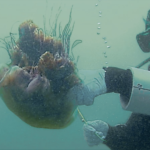Paper, Vertical and horizontal movement patterns of scyphozoan jellyfish in a fjord-like estuary
Currently there are many designs that are modeled after marine animals. For example, wind turbines are modeled after the fins of whales when they swim. Little is known about the jellyfish’s movement, however. This paper explores the science behind the swimming mechanism of a jellyfish. The researchers found out that jellyfish swim by 2 main mechanisms, which are separated into vertical and horizontal movement. The speeds in which the jellyfish travel depends also on the tidal period. In both vertical and horizontal movement, the jellyfish moved faster during night time where tides are drawing downwards. We can apply this same concept to modern transportation systems in the ocean. By replicating the propelling movement of the jellyfish, as well as the motions of waves, we can potentially find a more efficient mode of transportation.
Learn about our two Decals!
 Click here to find out more about our Fall Bioinspired Design Decal and our Spring Bioinspired Design in Action Decal – ALL MAJORS are welcome.
Click here to find out more about our Fall Bioinspired Design Decal and our Spring Bioinspired Design in Action Decal – ALL MAJORS are welcome.Berkeley BioDesign Community
 Click here to learn about the BioD: Bio-Inspired Design @ Berkeley student organization or here to signup for more info.
Click here to learn about the BioD: Bio-Inspired Design @ Berkeley student organization or here to signup for more info.Search
Student Login





I imagine that the neurological circuits underlying these processes are governed by both 2d spacing maps with their brains as…
to reduce the impact of car accidents, it may be possible to study the force diverting physics of cockroaches to…
you see this type of head-bobbing stability in many avian creatures related to pigeons like chickens. the head ability to…
not like they taught horses how to run! this is an example of convergent evolution where both sea creatures and…
The brain functions in a similar way with neuronal connections. our brains are able to utilize the multiplicity of connections…